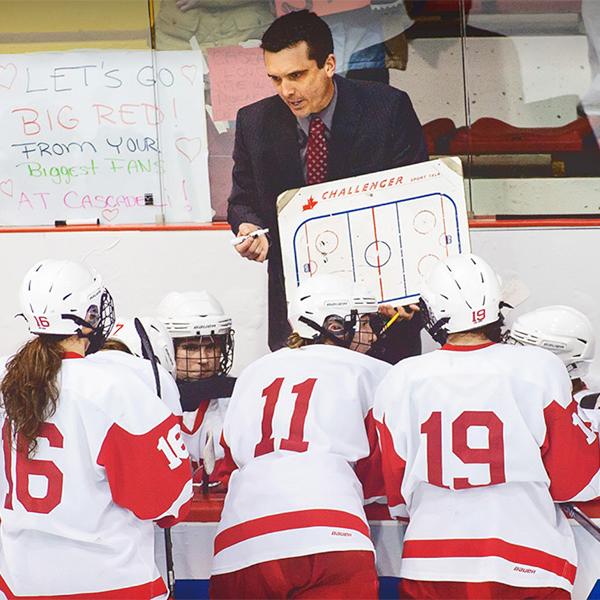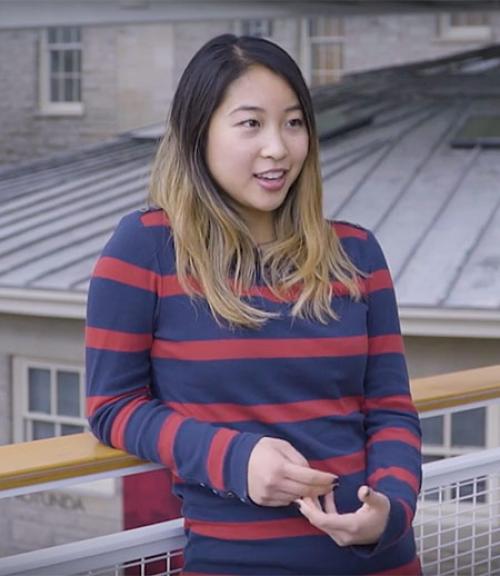The College of Arts and Sciences has announced a $2.7 million expansion of its Active Learning Initiative (ALI), which began five years ago with the conversion of four large course sequences in physics and biology. Thanks to the generosity of Alex and Laura Hanson, both Class of 1987, six new projects will be launched in the Departments of Music, Classics, Economics, Mathematics, Physics, and Sociology.
“These new projects reflect the college’s commitment to education innovation and to partnering with departments and faculty who have creative ideas about teaching and curriculum development,” said Gretchen Ritter, the Harold Tanner Dean of Arts and Sciences. “This expansion of the Active Learning Initiative is going hand-in-hand with the College’s curriculum effort and I am excited about the great ideas emerging from both efforts. We are deeply grateful to the Hansons for making these new projects possible.”
Biological sciences major Clara Liao ‘17, discusses her experience taking an Active Learning Initiative class from Professor Ron Harris-Warrick and how it differentiates from other traditional classes she’s taken in her major.
According to Peter Lepage, director of education innovation and Goldwin Smith Professor of Physics, the new projects will have an impact on thousands of students each year. The economics courses that will be converted, for example, last year reached 3,434 students (majors and non-majors) across the university.
“The projects chosen outline clear ideas that will improve student learning in ways that can be measured, and therefore propagated to other courses and departments,” said Lepage. “And they involve teams of faculty that will generate new energy and thought around pedagogy in the departments and the rest of the college.”
Hanson noted that donors and volunteers want to make a positive impact, and “Laura and I have been impressed with the game-changing quantitative and qualitative results so far [of the ALI],” he said. “The College has demonstrated both a large treatment effect and a statistically significant improvement. This is a testament to terrific work by the leadership, faculty, postdocs and students. We are confident the investment in the next phase will pay even greater rewards.”
In active learning classrooms, the emphasis is on hands-on activities and frequent student-student and student-instructor interactions through methods such as small discussion groups, partner sharing and the use of technology like iClickers and smartphone apps to enhance learning. Rather than traditional lecture, students gain information in advance of class through videos, readings, online exercises and quizzes, so that class time is spent on building expertise through problem-solving, experiments and group discussions.
Measured results from the ALI courses at Cornell have shown significant improvements in student learning, with grade improvements across the board. The biggest gains come from students who had been receiving poor grades, according to Ron Harris-Warrick, the William T. Keeton Professor of Biological Sciences in the Department of Neurobiology and Behavior, who has used active learning in a large 175-student introductory class and a smaller 60-student class.
Professor Julia Thom-Levy discusses her experience shifting Mechanics and Thermal Physics to an Active Learning Initiative course.
Participating faculty have expressed considerable enthusiasm about the new projects, including the opportunity to scale up what’s already working and to share successful strategies across courses. The chance to evaluate student learning outcomes is also welcome, say faculty participants: all the projects include rigorous assessment components.
The Center for Teaching Excellence has been an important resource for the faculty developing the projects, noted Lepage. “Associate Director Amy Godert especially has been an enthusiastic partner in the ALI initiative,” he said.
Music
The music department project takes advantage of new technologies and reflects the keyboard’s historically important role in the acquisition and deployment of digital techniques. By networking keyboards in a classroom environment and registering their input via a new software platform to be developed to fit the specific needs of Cornell’s faculty and students, the project will enable instructors to gain deeper and more granular insight into how students absorb theoretical concepts—and, just as importantly, how they learn to deploy them in their own music-making endeavors, according to Roger Moseley, assistant professor of music and project lead.
“The creation and performance of music has always involved active learning,” he said. “But by enabling students to put theoretical concepts into practice at the keyboard while their instructors and peers provide real-time feedback, the proposed software platform promises to revolutionize how musical thought can be framed, grasped, and made audible."
Economics
The economics project will overhaul the entire core curriculum for training undergraduates in economics and related disciplines, infusing seven required core courses and one popular elective course with evidence-based teaching techniques that improve both student learning and retention. In most economics departments, the subject is taught primarily in a pure lecture style. Yet, said project lead Doug McKee, senior lecturer, research has shown over and over in STEM fields that active learning methods lead to improved learning and “we see every reason these findings should apply in our field too.”
McKee said that the project will place a strong emphasis on evaluation, both quantitative and qualitative. “As we try new methods with new courses and faculty it will be critical to know what's worked and what hasn't,” he noted. “That means investing in good student assessments and carefully looking at the effects of our changes on the whole range of students that take our classes.”
A&S Biology major Nnana Amakiri ‘17 discusses his experience taking an Active Learning Initiative class.
Sociology
The sociology project will infuse several large, lower-division introductory courses with active learning; every year, more than 1,000 students from across Cornell take such courses in sociology. According to Associate Professor Vida Maralani, co-lead for the project, these students are socially and economically diverse, in part because the topics covered in sociology’s introductory courses – like inequality, race and ethnicity, gender, and immigration -- resonate with students from many different backgrounds.
“The more we can actively engage our students, the more opportunities we provide for students to challenge their preconceived beliefs about social processes, learn from their peers, and develop the skills to think critically about social structure, social dynamics, and the promises and pitfalls of social scientific modes of inquiry,” said Maralani.
As part of the project, a database of activities will be developed that can be used by faculty and teaching assistants to infuse their courses with active learning strategies. “We’re excited to develop materials for our introductory courses and to learn how to effectively transfer these strategies across different instructors of the same course,” said project co-lead Kim Weeden, Jan Rock Zubrow '77 Professor in the Social Sciences and chair of sociology.
Classics
The classics project will create courses that give foundational windows into major themes/areas in classics with wider cultural and historical relevance and as vehicles by which a specific topic area can address broad learning aims. The courses will offer immersion in a set of sources and intellectual topics, ancient and modern. “We’re excited about the opportunity to take a core strength of our discipline -- close classroom engagement with students in exploring complex ideas collaboratively -- and scale it up so many more students can have those experiences,” said Courtney Roby, assistant professor and director of undergraduate studies for classics.
Roby added that the courses will be designed to be team taught, offering a broader spread of expertise and illustrating there are plural approaches to all material and topics. “A long-term value of the project will be the skills that we as a faculty develop and can then share amongst ourselves. We’re looking to build a lasting culture of creative active-learning course design that will benefit our students for years to come,” she said.
Professor of ecology and evolutionary biology, Harry Greene, discusses his experience shifting Evolutionary Biology and Diversity to an Active Learning Initiative course.
Mathematics
The mathematics department served nearly 7,000 students in 2016, and every year, more Cornell students at every level need more types of mathematics to succeed in their majors and their careers. The mathematics project will implement systemic change in how courses are taught that reach students at critical transition points in their mathematical development. Goals for the project include increasing student confidence in their own mathematical abilities and improving student perception of mathematics as an inquiry-based discipline.
According to project lead Tara Holm, professor of mathematics, “Our vision for this initiative is to narrow the gap between mathematics as it’s practiced in the world and mathematics as it is experienced in the classroom. The role of mathematics in our society has become more pervasive, diverse, and integral to the other sciences and to society. We intend to work with faculty in other disciplines to ensure we are teaching the mathematics they need their students to know, in ways that make the transfer of mathematics to other disciplines smoother.”
Physics
The physics project is a way to rethink labs as vehicles for developing students' scientific reasoning, critical thinking, and experimentation skills, according to project lead Natasha Holmes, assistant professor of physics. “One of the biggest goals for these redesigned courses is to get students thinking critically about the data they collect, the models they develop and evaluate, and the conclusions they draw,” she explained. “Critical thinking in this way is an important and broadly applicable skill, both in and outside of science.”
Because the new courses will reach thousands of students and dozens of graduate teaching assistants through six different courses, Holmes said, “We have an opportunity to make a significant impact on students’ education here at Cornell.”





